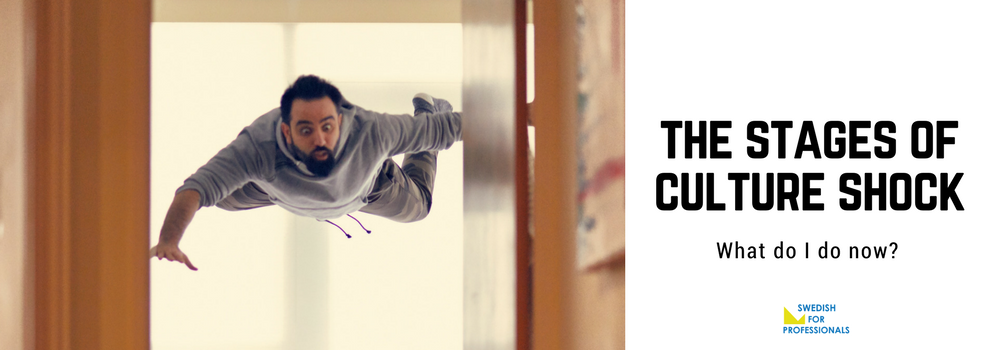[vc_row type=”in_container” full_screen_row_position=”middle” scene_position=”center” text_color=”dark” text_align=”left” overlay_strength=”0.3″ shape_divider_position=”bottom”][vc_column column_padding=”no-extra-padding” column_padding_position=”all” background_color_opacity=”1″ background_hover_color_opacity=”1″ column_shadow=”none” column_border_radius=”none” width=”1/1″ tablet_text_alignment=”default” phone_text_alignment=”default” column_border_width=”none” column_border_style=”solid”][vc_column_text]
Moving abroad can be an exciting experience! Many new impressions, unfamiliar surroundings and new people and activities. However, all these exciting new experiences might also lead to a feeling of being a little bit lost.
Culture shock is common among expats and people who have moved far away from home. It can be developed even after you have settled in and have become familiar with the norms and culture of your new home, Sweden for example!
[/vc_column_text][/vc_column][/vc_row][vc_row type=”full_width_background” full_screen_row_position=”middle” equal_height=”yes” content_placement=”middle” scene_position=”center” text_color=”dark” text_align=”left” top_padding=”4%” bottom_padding=”8%” overlay_strength=”0.3″ shape_divider_position=”bottom” shape_type=””][vc_column column_padding=”no-extra-padding” column_padding_position=”all” background_color_opacity=”1″ background_hover_color_opacity=”1″ column_shadow=”none” column_border_radius=”none” width=”1/2″ tablet_text_alignment=”default” phone_text_alignment=”default” column_border_width=”none” column_border_style=”solid” offset=”vc_col-xs-12″][image_with_animation image_url=”3749″ alignment=”” animation=”Fade In From Left” border_radius=”none” box_shadow=”small_depth” max_width=”100%”][/vc_column][vc_column column_padding=”no-extra-padding” column_padding_position=”all” background_color_opacity=”1″ background_hover_color_opacity=”1″ column_shadow=”none” column_border_radius=”none” width=”1/12″ tablet_text_alignment=”default” phone_text_alignment=”default” column_border_width=”none” column_border_style=”solid” offset=”vc_col-xs-12″][/vc_column][vc_column column_padding=”no-extra-padding” column_padding_position=”all” background_color_opacity=”1″ background_hover_color_opacity=”1″ column_shadow=”none” column_border_radius=”none” width=”5/12″ tablet_text_alignment=”default” phone_text_alignment=”default” column_border_width=”none” column_border_style=”solid” offset=”vc_col-xs-12″][vc_row_inner column_margin=”default” text_align=”left”][vc_column_inner enable_animation=”true” animation=”fade-in-from-bottom” column_padding=”no-extra-padding” column_padding_position=”all” background_color_opacity=”1″ background_hover_color_opacity=”1″ column_shadow=”none” column_border_radius=”none” width=”1/1″ column_border_width=”none” column_border_style=”solid” delay=”50″][vc_custom_heading text=”A person experiencing culture shock usually moves through four stages: honeymoon, frustration, adjustment, and adaptation. And even though this order of stages is the most common, a person might find himself experiencing these stages in a slightly different order. Let’s break them down!” font_container=”tag:p|text_align:left|color:rgba(10%2C10%2C10%2C0.75)” use_theme_fonts=”yes” css_animation=”none”][/vc_column_inner][/vc_row_inner][/vc_column][/vc_row][vc_row type=”in_container” full_screen_row_position=”middle” scene_position=”center” text_color=”dark” text_align=”left” overlay_strength=”0.3″ shape_divider_position=”bottom”][vc_column column_padding=”no-extra-padding” column_padding_position=”all” background_color_opacity=”1″ background_hover_color_opacity=”1″ column_shadow=”none” column_border_radius=”none” width=”1/1″ tablet_text_alignment=”default” phone_text_alignment=”default” column_border_width=”none” column_border_style=”solid”][vc_column_text]
1. Honeymoon
The first stage is usually characterized by an extremely positive feeling, almost euphoric. Everything is new and exciting! You might be thinking “This is the best decision I’ve ever made! Sweden is great and everything is really well organized! I can even find stores where I can buy local products from my country!”.
2. Frustration stage
During this phase, a strong feeling of dissatisfaction kicks in and the excitement quickly starts turning into discomfort. Impatience, anger, and sadness are all characteristics of this stage. Miscommunication and failure to understand gestures are a source of frustration, and even the simplest thing might be able to trigger you! For example “why is everyone so obsessed with the weather?” or “why do people use passive-aggressive notes instead of talking to each other?”
3. Adjustment stage
You slowly begin to gain a sense of direction and surely begin to feel more familiar and comfortable with the people, culture, food, and surroundings of your new environment. You might have also established some friendships that make you feel more like home! Everything starts getting in order and you are ready to move to the next phase. You have already started eating lunch at 12:00 and dinner at 18:00 as a real Swede!
4. Adaptation stage
[/vc_column_text][vc_row_inner column_margin=”default” top_padding=”3%” text_align=”left”][vc_column_inner column_padding=”no-extra-padding” column_padding_position=”all” background_color_opacity=”1″ background_hover_color_opacity=”1″ column_shadow=”none” column_border_radius=”none” width=”1/1″ column_border_width=”none” column_border_style=”solid”][vc_column_text]Cultural shock is a natural part of a cross-cultural experience that traveling and living abroad entails. Everyone experiences it. Going through the different stages can take weeks, months or years. If you feel like you need some help along the way, you can read more about our Swedish culture workshops here. Don’t forget to also follow our Facebook and Instagram accounts for some interesting facts and useful tips about living in Sweden![/vc_column_text][/vc_column_inner][/vc_row_inner][/vc_column][/vc_row]

